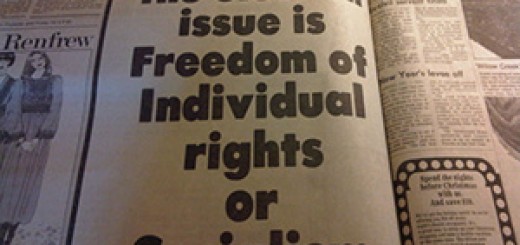Ktunaxa Nation v British Columbia (Part 2): On Review and Consultation

Part 1 of TheCourt.ca’s coverage of Ktunaxa v BC covered the decision’s contribution to freedom of religion jurisprudence. In part 2, I ask:
What does an obscure snowy mountain in British Columbia have to do with a much less snowy, much more famed mountain in Jerusalem?
The answer to that question is: “probably not a whole lot.” Unless, of course, you were party to Ktunaxa Nation v British Columbia (Forests, Land and Natural Resource Operations) 2017 SCC 54 (“Ktunaxa”). One question at the hearing of the recently released Supreme Court of Canada (“SCC”) decision was whether the Ktunaxa Nation was asking the Court to sanction a Canadian Temple Mount. The Ktunaxa’s “no middle ground” position left the Court in a bind: either deny the freedom of religion claim or effectively grant the Ktunaxa a property interest in the land at stake.
The case’s history, the SCC hearing and contribution to freedom of religion jurisprudence have been eloquently covered by Lilliane Cadieux-Shaw and Kristopher Kinsinger, respectively. But the decision has many layers, reflecting the multiple socio-legal issues the Court was grappling with. Initially, I was going to focus on varying conceptions of land as reflected in the arguments and the decision. While land will play a role in my comments, in this post I want identify the impact of the case on administrative law, and Section 35 claims.
Dorr…What? Where?
While the commentary on Ktunaxa has primarily focussed on its narrowing of the scope of Section 2(a), one key point of contention between the majority and concurring opinions is the standard of review. The framework for reviewing administrative decisions invoking the Charter rights was established in Doré v Barreau du Québec, 1 SCR 395 [Doré], which held that a deferential standard of reasonableness would apply. Although Ktunaxa challenged the Minister’s decision through an application for judicial review, the majority opinion does not discuss the appropriate standard of review or apply Doré. Instead, the Chief Justice and Justice Rowe use a Charter rights analysis when considering the freedom of religion claim and administrative law principles when reviewing the consultation process. So where are the Charter values? And what about deference? I think that the majority may be implying that there is a standard of correctness in determining the threshold question of whether the Charter claim falls with the scope of the right. If freedom of religion is not even engaged, there is no need to move on to a balancing exercise under either the Oakes or Doré framework. This move reserves the Court’s right to determine the scope of religious freedom, rescinding some of the deference to administrative decision makers we have grown accustomed to. Additionally, it avoids any justification, whether the burden be on the Minister or the claimants.
Even though the result is the same, Justice Moldaver does apply the Doré framework. Instead of separating the two issues, he asks whether the Minister properly balanced the statutory objectives and the freedom of religion claims. Justice Moldaver would have retained a broad definition of freedom of religion, moving any discussion of limits to the proportionality or balancing stage of the analysis. Further, he folds the 2(a) claim into the duty to consult analysis, concluding that the Minister was implicitly alive to spiritual concerns during the consultation process. This approach avoids the incongruency of analytical paths between legal issues. However, applying Doré invokes some of the general problems with that framework: the Charter claim is lowered so it is at the same level as (or perhaps even subordinate to) the statutory objectives. This means that no additional weight is afforded to the Ktunaxa’s freedom of religion claim vis-à-vis the statutory objective of disposing the land in the public interest (para 155). Further, both approaches lead to the same result, a reminder that the space between correctness and reasonableness may not be as far as we think.
Treating likes alike…
There were two issues in front of the Court. The second issue was whether the nearly 20-year consultation conducted by the Minister satisfied the Crown’s section 35 duty to consult. This raises the interesting question about the relationship between Indigenous and Charter rights. Before proceeding to resolve the two legal issues, but not without its own contention, the Court draws a sharp line between the two. When considering the freedom of religion claim, “the Ktunaxa stand in the same position as non-Aboriginal litigants” (para 58). Although the Court’s traditional conception of religion is amorphous and the 2(a) test capacious, the freedom of religion claim here fails. Through the register of equality – with the stated objective of treating religions alike – the majority draws borders around religion in which typical manifestations of Indigenous religion do not fit.
By completely separating the two legal issues, the majority also draws borders around the Section 35 analysis. It is interesting that as the Court moves from a freedom of religion to a duty to consult analysis, there is also a shift in terminology. Where the Ktunaxa’s freedom of religion claim failed, the Minister properly accounted for the Nation’s spiritual concerns. Is there a difference between religion and spirituality? While the two are not coterminous, they are often related. Only one, however, enjoys Charter protection. Religion plays a different role in the analysis depending on the legal issue. While a freedom of religion claim would have purportedly vetoed the proposed ski resort, spiritual concerns only had to be considered during the consultation process. Notably, this shows the limits on the Charter’s promise, especially for Section 35 claims.
Consultation
Then what does the duty to consult under Section 35 promise? The disjuncture between the majority and concurring opinion shows different approaches to administrative law, yet both are satisfied by the consultation process. Both agree the duty to consult and accommodate was met, notably emphasizing the process. As the majority affirms, Section 35 is about the process: what matters is that the Crown acts honourably, and not that there is a specific result (para 79). The additional caveat is that the Indigenous groups do not have a veto over developments, instead, “what is required is a balancing of interests, a process of give and take” (para 80). Clearly, the Court envisions a negotiation-like consultation process; one targeted to the specific development at issue where the Minister and the affected Indigenous communities are the primary parties.
There is an interesting distinction made in process between the duty to consult and a rights declaration under Section 35. The who for the duty to consult, flowing from the honour of the Crown, is the Minister. The consultation process is subject to review by a Court on a standard of reasonableness. Further, the substantive result is to some extent irrelevant. However, Courts play a much more active role in a very different process when declaring an Aboriginal right under Section 35. In Ktunaxa, the Court is very critical of the Ktunaxa’s attempt to ask the Court to declare an Aboriginal right “under the guise of” judicial review. A rights declaration can only be made through the proper judicial proceedings: “Aboriginal rights must be proven by tested evidence; they cannot be established as an incident of administrative law proceedings” (para 84). While both of these processes are burdensome on the Indigenous claimants (albeit in different ways), this statement restricts the declaration of an Aboriginal right to the courts.
The focus on process also highlights the unbalanced dynamics in the Section 35 jurisprudence. Both processes have been built by common law judges based on certain assumptions of who is accommodating whom. The duty to consult is limited in its objectives, and may only result in a modification in development plans, not a veto. The underlying assumption in the consultation process is that land is a resource to be developed in the public good. Is there even space here to negotiate land as something spiritual? Take, for example, Justice Moldaver’s comments that “Granting the Ktunaxa the power to veto development would effectively give the Ktunaxa…the power to exclude others from developing land that the public in fact owns” (para 150). The consultation process inevitably drives the substantive result, yet the process starts with partisan conceptions of land or resource development.
Moreover, the image of accommodation is one where the Minister reaches out to and makes room for the needs of affected Aboriginal communities. While this isn’t nothing, it assumes the legitimacy of the Minister, Canadian claims to land and a subordinate position of Indigenous groups. Therefore, this process – which according to the Court is at the heart of Section 35 – may reinforce unequal dynamics that do not actually get us any closer to reconciliation.
Conclusion
So in the end we don’t have a Canadian Temple Mount. Were we ever going to have one? In my opinion, it isn’t effective to compare the Ktunaxa’s claim to that of extremely contested and politicized land in the Middle East. Doing so decontextualizes and depoliticizes the deep and important issues we are grappling with in Canada. Evoking images of Jerusalem means we can forget about reconciliation, about lands as a resource versus land as spirituality in favour of “treating likes alike.”
This case was not just about religion (is it ever?), but about how and who makes decisions about rights and ski resorts. Not only does the decision imperil the Doré framework, but it narrows our understanding of religion in potentially discriminatory ways. It further reminds us of the division of powers between courts and administrative actors, between the work of judicial proceedings and judicial review. Finally, it demonstrates the normative influence on process, and the impact of that process on substantive results. While Ktunaxa means we do not have a Canadian Jerusalem, the decision leaves us grappling with uniquely Canadian questions of reconciliation and diversity.







Join the conversation